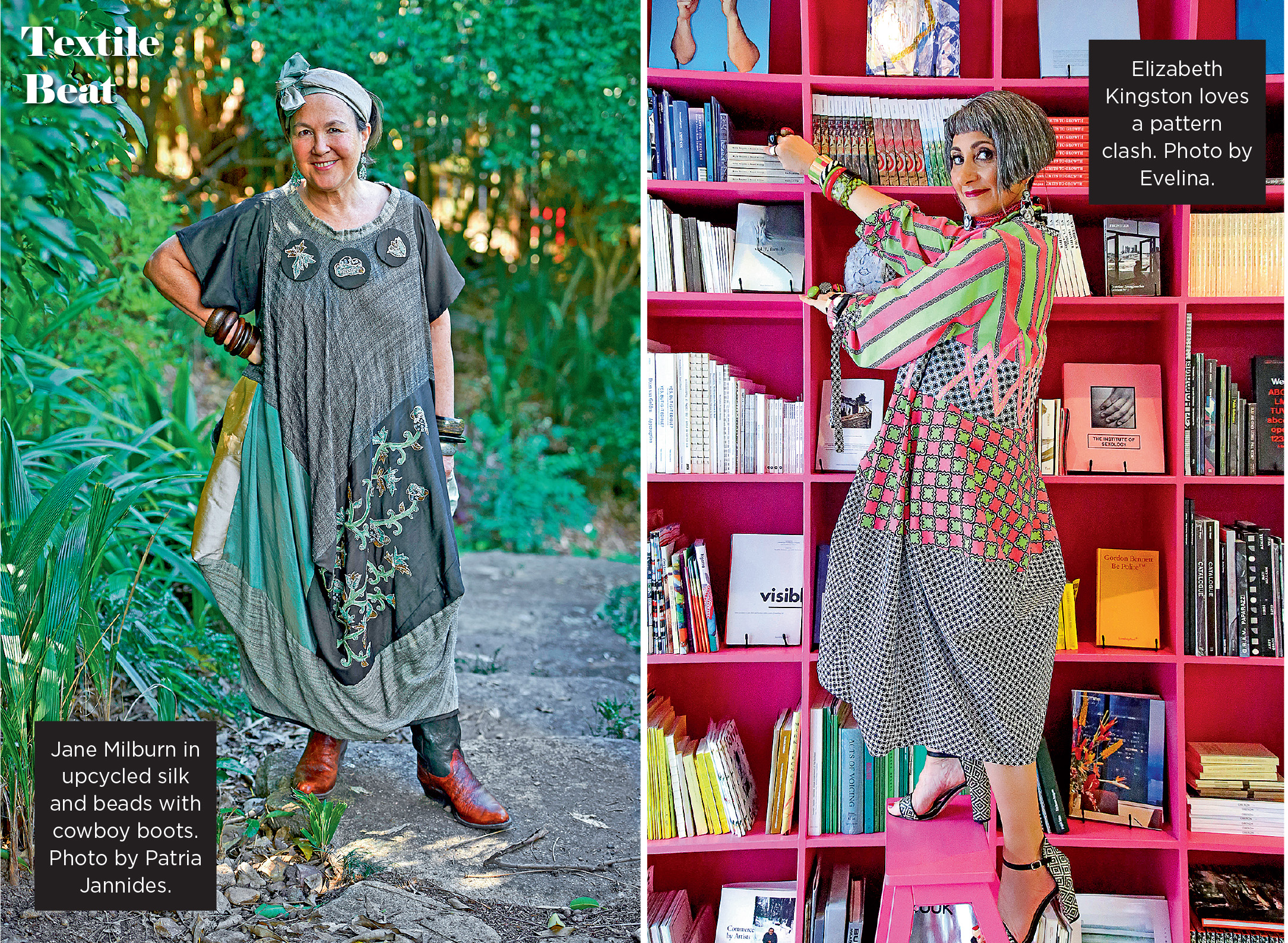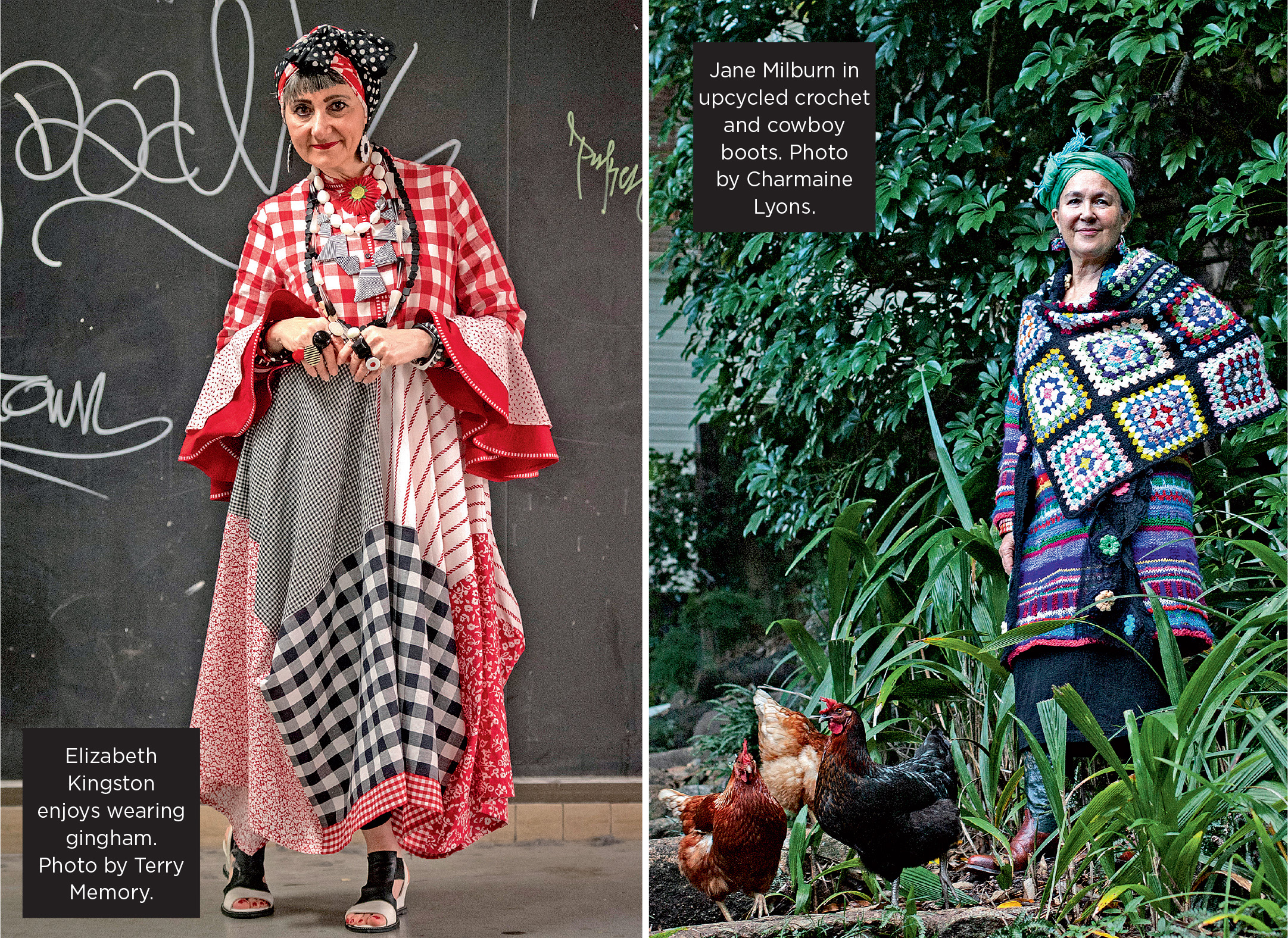When we follow a predictable path, we walk in another’s shadow. Only when we explore our own creativity and embrace the unusual can something original emerge. Jane Milburn reports
What is unusual? The dictionary says it is something remarkable or interesting because it is different from or better than others. Synonyms include extraordinary, singular, particular, marked, outstanding, notable, distinctive, striking, unique, unparalleled, mind-blowing and superior.

Jane Milburn, left, and Elizabeth Kingston, right, wear their own style. Photos by Patria Jannides and Evelina.
Being unusual sets us apart from the usual. Some people avoid being unusual and go to great lengths to fit in, to conform, to dress according to conventions and fashions of the day, to not stand out from the crowd. They feel safety in conforming and fitting in.
Embracing the unusual can be about risk-taking, daring to show up as your authentic self. While it may be risky to expose your true self, anything else is contrived. Finding your unusual, authentic self is a pathway to self-realization rather than being a cardboard cutout of someone else’s expectations.
Embracing the unusual can be about embracing imperfection. While that can be challenge for some, it makes life easy because being perfect is impossible to maintain.
Embracing the unusual honours uniqueness. In contemporary culture speak, that means NOT following the crowd or the current ‘must have’ items to keep up with the Jones or the Kardashians.
Must-have bags and colours of fashion marketing were always lost on me. I value uniqueness and don’t feel pressure to follow trends to fit in or be accepted. I always had the feeling I was singing from a different song sheet to the mainstream.
I grew up at a time before fast fashion on a sheep farm in the South Island of New Zealand and that’s where I track back my love of natural fibres and making things with my own hands. Our great grandma lived on the farm with us, she was of Ngai Tahu and Scottish heritage, and taught us handmade skills and values that are still with me today.
Fast forward through a rural communications career to a preloved Fashion for Flood fundraiser in 2011 in Brisbane where I observed the excess of clothes and predominance of synthetic fibres. I aligned my work to my values of authenticity, creativity, autonomy and purpose in 2013 and created Textile Beat to enable conversations about the way we dress.
It seems the desire to fit in and follow trends – rather than embrace the unusual – unleashed a fast fashion industry that is a toxic combination of cheap labour and cheap synthetic fibres leading consumers to buy two to four times what they need, creating waste and pollution, and a loss of skills and knowledge about where and how clothing is made. I found voice around these issues and sang louder from my own script.
Years of hands-on upcycling, independent research and advocacy work became a book, Slow Clothing: finding meaning in what we wear, which celebrates self-empowerment through resourceful thinking and individual actions to embrace the unusual.
While some social mores and judgements may constrain us, it is heartening to see individualism arising as we embrace our unique, unusual, original selves and show personality through what we wear rather than choosing something straight off a fashion rack.
Some people go through their entire life conforming. The confidence to back yourself is hard, it takes courage and self-confidence. The irony is when you back yourself and explore what matters to you, you grow in confidence. That is hard if being a people pleaser is important to you, because you will want to conform, be usual, to fit in.
So here’s the challenge: be a goat, not a sheep. Ride the boundaries, take risks and be prepared to forage rather than plodding the well-worn, predictable path. Why be a follower when you can embrace your uniqueness?
Encourage our teenagers and timid types to show their personality instead of being one of the herd. Because when we seek to conform and not be unusual, we lose the opportunity to be mindful and resourceful through the act of making and creating something different.

Elizabeth Kingston, left, and Jane Milburn, in self-styled creations Photos by Terry Memory and Charmaine Lyons
Design consultant and sewist Elizabeth Kingston says that sewing has afforded opportunities to be as creative as her heart desires, unhindered by current trends in garment style or colour.
“I choose to embrace the unusual by combining a variety of patterned fabrics which aren’t always expected to be found together: stripes and spots; checks and florals; clashing geometrics. The final outcome creates a story which is often dramatic, enhancing the silhouette of my garment and expressing the playful side of my personality,” Elizabeth said.
“The process can begin with a single piece of fabric I have purchased, to which I will add to over time, from either my extensive stash or additional pieces I came across over the following months (or sometimes years!), as was the case with the fuchsia and lime green dress. Trimmings, such as ribbons and self-made bias binding often feature as another element of pattern.
“Sometimes I begin with an existing garment in my wardrobe (such as the preloved gingham shirt), which I cut into (altering the length and sleeves) and refashioned into a dress with the addition of remnant lengths and leftovers from previous projects.
“I love exploring new combinations of colour, texture and pattern (be it as print or woven). Experimentation is the key to keeping my creativity alive.”
First published in Ruth magazine, Summer edition 2020.